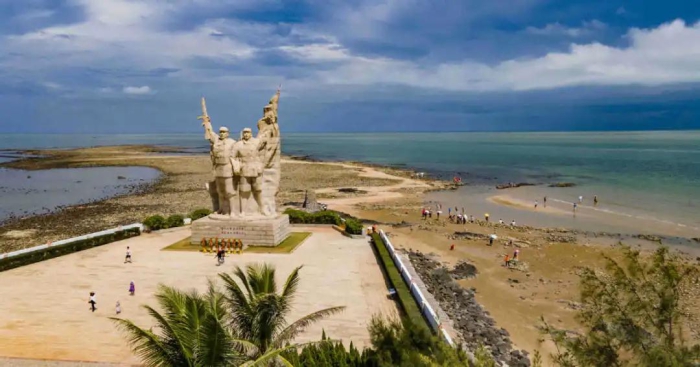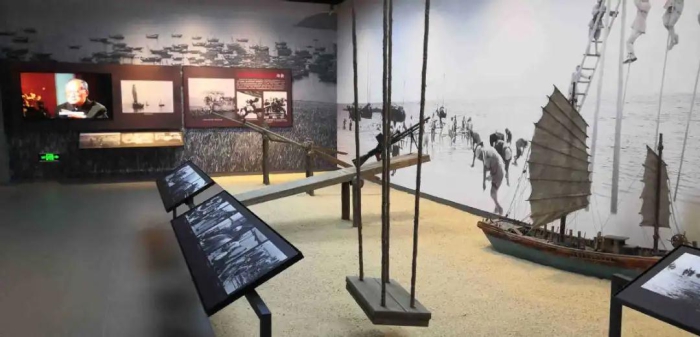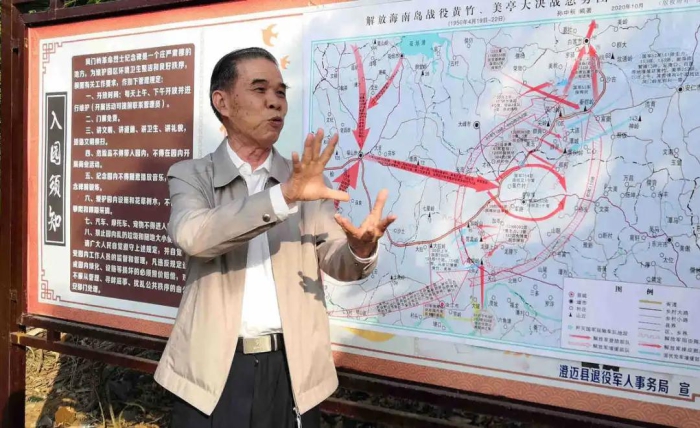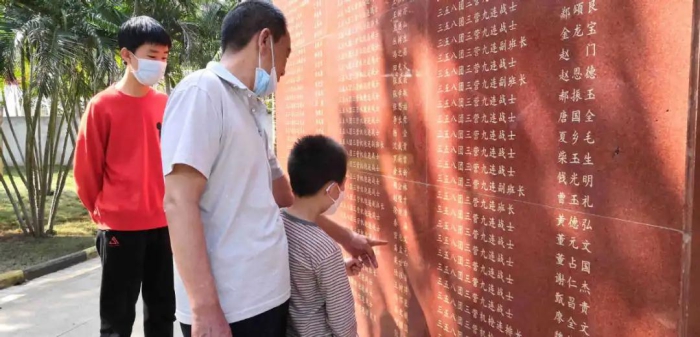At the memorial hall of the Hainan Island Liberation Park in Lin'gao, a wall featuring bronze-framed fingerprints and the footprints of soldiers who once fought in cross-sea battles and who are still alive, is eye-catching and evokes memories of those arduous yet heroic days of war.
Fingerprints and footprints of PLA soldiers who once fought to liberate Hainan Island are on display. [Photo by Ma Zhiping/ chinadaily.com.cn]
The Lin'gao headlands stick out like a paddle from the western coast of Hainan island, jutting into the Qiongzhou Strait, which separates the tropical island from the Chinese mainland. The waters are a natural wonder: The eastern side often sees wild, roaring waves, while the western side remains calm, rippling and sparkling, making it an ideal place for landing small boats.
And this was one of the major locations on Hainan Island where a mass landing of 25,000 People's Liberation Army troops took place 71 years ago.
Landing of the PLA main troops at Lin'gao headlands on April 17, 1950, about five months after the founding of the People's Republic of China, made the coastal site an appropriate place to create a national education base — Hainan Island Liberation Park — which attracts crowds of visitors daily.
Hainan Island Liberation Park at Lin'gao headlands. [Photo by Chen Yuancai/For chinadaily.com.cn]
Experts who have studied the 58-day Hainan liberation campaign said the endeavor was a marvel of amphibious operations during the war, with PLA soldiers in small wooden sailboats defeating more than 100,000 Kuomintang troops.
At 35,000 square kilometers, Hainan is China's second-largest island, slightly smaller than Taiwan. It has played an important strategic role as a gateway to the South China Sea.
In late 1949, about 100,000-strong infantry force of engineers, signalmen and anti-tank and anti-aircraft artillery men from the 40th and 43rd Army with the 15th Corps under the Fourth Field Army were dispatched by the central government to the Leizhou Peninsula to form a cross-sea combat corps to liberate Hainan, which was then controlled by Chiang Kai-shek's Kuomintang troops. Some of those had recently retreated in defeat from the mainland, according to the Hainan Chronicles Museum.
The preparation work proved to be extraordinarily difficult, as the cross-sea troops had too few ships and soldiers, though courageous and brave enough in the field, became anxious as they had no experience with the sea. Many were seeing a sea for the first time in their lives, said experts on Hainan liberation history.
They said that over about three months the troops learned how to swim, mastered basic navigation techniques such as boat paddling and steering, determining the wind direction and playing on swings to overcome seasickness. The intensive training mostly took place at night and turned the land force into a navy.
The swings used by PLA soldiers to overcome seasickness. [Photo by Ma Zhiping/chinadaily .com. cn]
Lu Xiangyun, deputy platoon leader of the 28th division of the 43rd Army, encountered a Kuomintang warship with seven soldiers during a night of sea training. The warship fired at Lu's small wooden boat, but soon escaped when Lu suddenly ordered his soldiers to throw grenades. Their heroic deed — fighting a warship with a wooden boat — greatly enhanced the soldiers' confidence in the coming sea-crossing operation, said a guide at the Memorial Hall for Cross-Sea Battles to Liberate Hainan Island at the Hainan Liberation Park in Lin'gao.
"My father was sent there and stayed for about two months training the soldiers how to operate a boat," said Wan Ridong, son of Wang Xiaojing, a former soldier of the Qiongya Column, who died in 2020 at age 96.
"He returned on March 5, 1950 with the first group of the PLA, secretly crossing the sea and landing at Baimajing on the western coast. He joined the fight on the island," said Wan, adding that his father often told his grandchildren stories of how the soldiers had fought bravely on the island.
To coordinate with the field army in the sea-crossing battles, the Party committee of the Qiongya Column — using the former name of Hainan Island — organized support teams consisting of more than 60,000 people from the island. Meanwhile, the "one yuan" and "one bucket of rice" campaigns were launched to encourage the residents across the island to donate money and food to support the PLA's operations.
In two months, more than 3 million kilograms of grain was collected, along with more than 170 wooden sailboats. More than 400 boatmen were mobilized. The force broke through the enemy's heavy blockades and sailed in batches to Leizhou Peninsula on the opposite side of Qiongzhou Strait, which is about 11 nautical miles wide at its narrowest point. They reported promptly to the sea-crossing corps about the situation of the defensive forces, including hydrological and meteorological information about the ports and coastline of Hainan, according to documents displayed at the museum.
The liberation campaign started with small-scale secret sea-crossing operations. From March 5 to 26, 1950, more than 8,500 soldiers secretly crossed the Qiongzhou Strait in two groups and landed successfully with the strong cooperation of the Qiongya Column, breaching some points of the Kuomintang's island wide defense system that included 50 warships and more than 40 airplanes.
Their land strengthened the power of the Qiongya forces and provided valuable experience for coordinating a large-scale landing of the main body of troops, said Huang Hua, an official with the CPC history research office of the Danzhou CPC city committee.
Large-scale battles on the island began on April 17 with landing of the main force. While the sea-crossing operations were nothing but sailing and full of dangers and challenges, the land battles were a matter of life and death engagements with the enemy. The 40th and 43rd Corps of the Fourth Field Army, led by Han Xianchu and Li Zuopeng, respectively, fought side by side and achieved an unprecedented success, according to the memorial hall.
Sun Zhongji, former head of the CPC history research office of the CPC committee of Chengmai county, tells the war story of Fengmenling Hill. [Photo by Ma Zhiping/ chinadaily .com. cn]
Surrounded by a pine forest about 1 kilometer north of Tancheng village of Laocheng in Chengmai county at the northern part of Hainan, a monument and tomb commemorate the Fengmenling revolutionary martyrs.
On April 21, in the blocking battle at Fengmenling Hill which was 105 meters high, the Kuomintang troops discharged thousands of shells at the 105 highland held by more than 200 soldiers from the 43rd Army. KMT planes dropped more than 600 bombs, which peeled off more than 1 meter of the hill. The company of PLA soldiers repulsed the KMT army's successive attacked 13 times, killing more than 500 and injuring more than 1,300. The PLA also attacked one plane, said Sun Zhongji, former head of the CPC history research office of the Chengmai CPC county committee.
"Relying on undaunted heroism and fighting spirit, 13 PLA soldiers survived the battle and persisted to the final victory, which played an important role in helping annihilate the enemy at Huangzhu and Meiting, two strategic positions for the KMT's troops," Sun said.
The PLA troops marched on from north to south with determined steps. On May 1, 1950, Hainan was liberated, and five-star red national flags were raised at Tianyahaijiao, the southernmost tip of the tropical island, now popularly known as China's Hawaii.
Operations map of the Hainan island liberation campaign. [Photo by Ma Zhiping/chinadaily.com. cn]
The Qiongya revolutionary armed force had grown up on Hainan Island since the 1920s under the leadership of the CPC and played a key role as an internal force in the process of the island's liberation.
"All our sea-crossing and landing operations have been carried out with the close cooperation of the Qiongya Column and support of the local people on the island. They are the fundamental guarantee of victory in the campaign," said officials with the 40th Army when summing up the landing operation on Hainan. "Without them, the achievements would not be so remarkable and the costs of the battles might have been much greater."
"Whenever the troops marched on, following them would be a long line of heavily loaded stretcher teams and transportation teams formed by the Li people, the original inhabitants of the island," wrote a war correspondent in Xinhua Daily.
Fu Shihe, at 93, one of the Li people at Qundian village, Dafeng town, Chengmai, still remembers the days when he used agility to stand toe-to-toe with his enemies to send water and food to the PLA soldiers 71 years ago.
Fu Shihe [Photo by Ma Zhiping/ chinadaily.com.cn]
"The aspirations for liberation of the local people on the island was an important factor that cannot be ignored in ensuring the success of the liberation of Hainan," said Zhong Yechang, chairman of the Hainan Federation of Social Sciences, in his work entitled Decoding the Liberation of Hainan Island.
About a month after the liberation, the Korean War broke out on June 25. The 40th Army, one of the main forces in the sea-crossing operation, became one of the first units to join that conflict. On June 27, the seventh fleet of the United States cut off the Taiwan Straits, according to an official history documentary.
The campaign was of great historical and practical significance to the country, said Mao Zhihua, director of the CPC History Research Office under the CPC's Hainan provincial committee.
He said: "For New China, the campaign of liberating Hainan Island was a large-scale amphibious campaign launched under the strategic eye of the Central Committee of the Communist Party of China, and Chairman Mao Zedong, which smashed the maritime deployment of counterattack against the mainland by the KMT authorities and its delusion of turning Hainan into a second Taiwan. It made Hainan a national defense outpost in the South China Sea."
He said that it made the people of Hainan masters of the island and started a new chapter by stepping onto the road of socialist prosperity.
A grandfather and his grandsons read the names of PLA heroes on a monument at the Hainan Liberation park in Lin'gao. [Photo by Ma Zhiping/ chinadaily. com.cn]
"Nearly 100 years have passed from the Qiongya revolution to the liberation of Hainan and the current construction of the Hainan Free Trade Port. But the spiritual strength has been passed down in a continuous line. This is a vivid portrayal of the original intention and mission of CPC members," Mao Zhihua said.
"In building Hainan Free Trade Port, we must always maintain the same spirit and energy — be patient, selfless and fearless to overcome difficulties —just as we had during the revolutionary war period," he said.
Experts said that, like the sea-crossing campaign 71 years ago, the construction of Hainan Free Trade Port is an unprecedented campaign that needs courage and innovative spirits to help turn Hainan into a more beautiful and prosperous island and a successful highland heralding the country's opening up.






